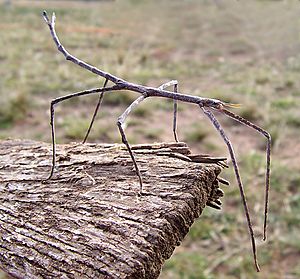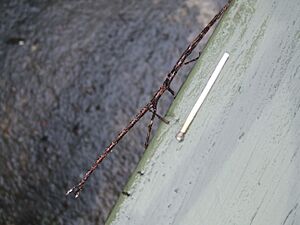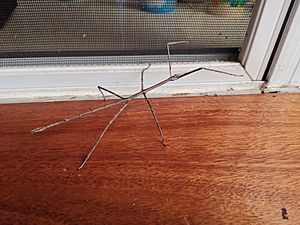Ctenomorphodes chronus facts for kids
Quick facts for kids Ctenomorphodes chronus |
|
|---|---|
 |
|
| Scientific classification | |
| Kingdom: | |
| Phylum: | |
| Class: | |
| Order: | |
| Family: | |
| Genus: |
Ctenomorpha
|
| Species: |
C. marginipennis
|
| Binomial name | |
| Ctenomorpha marginipennis Gray, 1833
|
|
| Synonyms | |
|
|
The Ctenomorpha marginipennis, also known as the margin-winged stick insect, is a cool insect found only in southern Australia. It's a type of stick insect, which means it looks a lot like a twig or a branch! George Robert Gray first described this species way back in 1833.
Contents
What Does It Look Like?
This stick insect is a master of disguise. It looks just like a eucalyptus twig! It can grow pretty long, up to 20 centimeters (about 8 inches).
- Males are long and thin. They have full wings and can fly around.
- Females are bigger than males. Their back wings are dark, almost black. But their wings are smaller than the males' wings.
Their legs and head are a light pinkish-brown color. The legs even have small teeth-like bumps. The middle part of their body, their wing covers, and their belly are all a dark greenish-black. Their belly also has many tiny spots. They have very long tail-like parts called cerci, which might also have small bumps.
Young stick insects, called nymphs, look similar to the adults. However, they only have tiny wing buds instead of full wings. You can tell this species apart from other stick insects by its super long cerci and the way its eggs look.
Where Do They Live?
You can find the margin-winged stick insect in heath areas and woodlands. They are quite common in southern Queensland, all the way down to Victoria. They especially like living near the coast.
How Do They Reproduce?
Female margin-winged stick insects lay oval-shaped eggs that are about 3 millimeters long. These eggs look a lot like plant seeds!
Like most phasmids (another name for stick insects), the female flicks her eggs onto the ground. Each egg has a small knob called a capitullum. This knob attracts ants, which then carry the eggs to their nests. The eggs hatch safely inside the ant nest.
This species can also reproduce through parthenogenesis. This means a female can lay eggs that hatch without needing a male to fertilize them!
What Do They Eat and How Do They Survive?
The C. marginipennis mainly eats leaves from eucalyptus trees. They also munch on leaves from other types of trees.
They are amazing at camouflage. Their body shape and colors help them blend in perfectly with eucalyptus twigs. This makes it very hard for predators to spot them!



